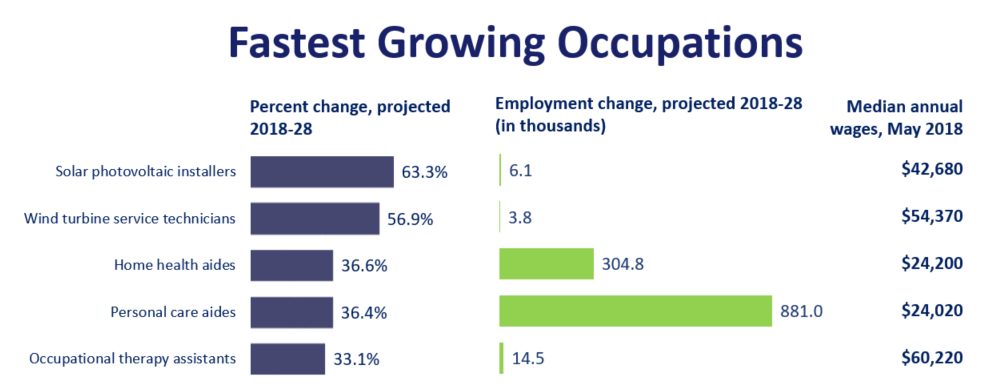By Richard Works and Stanislava Ilic-Godfrey
The US Bureau of Labor Statistics projects the top five occupations to grow the fastest from 2018 to 2028 are related to renewable energy generation and healthcare.
The two fastest growing occupations in America over the next ten years are backed by solar and wind energy sources. To help retrieve the energy from these sources, the Nation is projected to employ additional solar photovoltaic (PV) and wind technicians. Solar PV installers and wind turbine technicians are projected to grow over 50 percent within the 10-year period. Solar photovoltaic technicians install solar panels while wind turbine technicians install and maintain wind turbines. Renewable, alternative energy from solar and wind are growing in popularity due to a declining cost to build and install them, and efficiencies they create for businesses and individual households. Technological advances and innovations in solar and wind generation are expected to continue to drive down costs of the installation of solar panels and wind turbines.

Fastest growing segments
The US Energy Information Administration expects solar and wind to be the fastest growing segments of energy generations in coming years. In addition to single family homes, factories, warehouses, hospitals, public buildings include alternative energy source as part of government program or as their own investment. The US Energy Information Administration also projects that 31 percent of U.S. electricity will come from renewable sources by 2050. California and Massachusetts will soon require most of their newly built homes to have solar rooftop panels. These installations will contribute to the employment growth of solar PV installers. Wind farms as a source of energy generation are projected to expand both onshore and offshore to continue to harvest the benefits of this renewable energy source. As wind turbines are becoming bigger in size, they are able to garner more power than before. Additional wind turbine service technicians will be needed over the next ten years to support the expansion of new wind farms and the maintenance demand on the existing turbine.
The remaining three occupations in this group are related to healthcare support— home health aides, personal care aides, and occupational therapy assistants. Home health and personal care aides assist people with disabilities, chronic illnesses, physical or cognitive impairments in their daily living activities. Occupational therapy assistants also help people relearn some of the routine daily activities—eating, getting dressed, or brushing teeth, for example.

The aging population
A growing aging population and an increase in chronic diseases are two major driving factors behind demand for these health support occupations. According to the US Census Bureau, all baby boomers, the largest population group in the US, born between 1946 and 1964, will reach retirement age of 65 and older, within the projected period. By 2030, the older population will expand so that 1 in every 5 residents will be retirement age.
Longer-living seniors may decide to live their older years at their own homes, assisted-living facilities, or nursing homes. In each of these places, the elderly may require the assistance of either home health or personal care aides. People with chronic diseases also require the assistance of aides, home health and personal care aides, and occupational therapists. Severe diseases, such as cancer, heart diseases, stroke, associated with older adults may also affect younger population and can result in long-term disabilities.
People with these debilitating ailments may experience difficulty in daily lives’ activities—nutrition, personal hygiene, and household activities and may need assistance of workers from one in these occupations. For example, occupational therapy assistants also provide rehabilitative services to both young and the old with physical impairments, to regain some of their mobility skills.
Industry employment
On the industry side, industry employment is projected to grow at an annual rate of 0.5 percent from 2018 to 2028, slower than the annual rate of 0.8 percent from 2008 to 2018. Employment will increase to about 169.4 million over the projections decade.
The service-providing sector as a whole will grow at a projected rate of 0.6 percent annually, slightly faster than the annual rate of 0.5 percent for industry employment overall. This growth is projected to add more than 7.6 million jobs, resulting in 136.8 million jobs in the service-providing sector by 2028. After declining slightly from 2008 to 2018 (-0.3 percent annually), the goods-producing sector is expected to change little from 2018–28, with an annual growth rate of 0.1 percent.
Healthcare and social assistance
The healthcare and social assistance sector is projected to have the most employment growth. The sector is projected to increase by almost 3.4 million jobs and to reach over 23.3 million jobs in 2028. Employment in the healthcare and social assistance sector is projected to grow at a 1.6-percent annual rate, which is more than 3 times as fast as the overall annual growth of jobs in the entire economy. Still, this growth rate is below the 2.1-percent annual growth rate that occurred during the 2008–18 decade for the healthcare and social assistance sector.
The sectors projected to experience the fastest annual employment growth are health care and social assistance (1.6 percent), private educational services (1.2 percent), and construction (1.1 percent). These three sectors alone are projected to add more than 4.6 million jobs by 2028–including 3.4 million new jobs projected in healthcare and social assistance. Leisure and hospitality as well as professional and business services are also among the fastest growing at 0.9% and 0.8% respectively.


Bureau of Labor Statistics – Washington, D.C.
Ilic-Godfrey.stanislava@bls.gov
www.bls.gov
